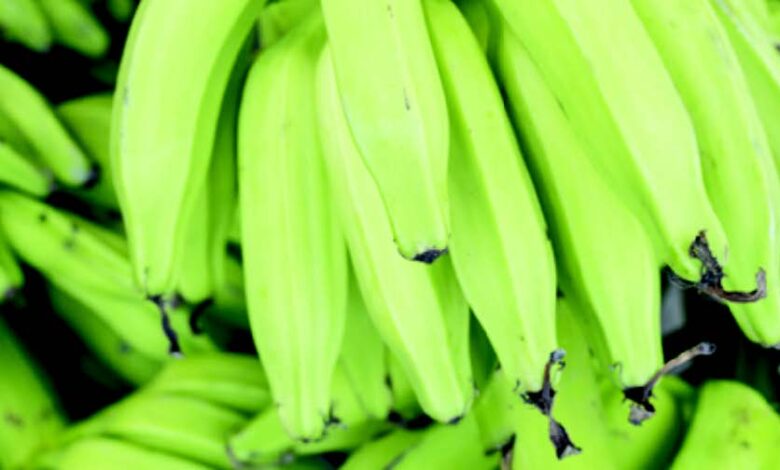
One interesting subject that was raised recently after my article on cassava fufu was whether plantain should dominate. Probably, the proponents could be right. However, I would try to answer this question in this article.
But first, you see, Plantain has been used as a Naturopathic remedy for years globally. For instance, one study by Arun et al.(2015) found that flour can be derived from plantain peel. The flour from the peel was found to be a very good source of antioxidant dietary fiber and can be used to make cookies.
Additionally, Dr. Axe in his plantain article in 2022 also found that:
- The flowers of the plantain are normally used as food in countries such as Vietnam, Laos, and the Philippines. The male flowers that bloom at the end of the shoot do not all mature to fruit. The flowers are used on salads or raw in vermicelli soup. There is also a type of dry curry called poriyal made in South India from plantain flowers.
- The leaves are also not left out as they have been used frequently because they are larger and stronger than banana leaves. Hence, they normally used them as food wrappers to gain a stronger aroma and flavor during cooking and preparing, and there are diverse variations of wrapping. In Ghana, we used them to wrap Waakye, Banku, and many more. I do remember, it is used as plates in the villages when we go to farms those days.
- Plantain shoots are also harvested after the fruit. The layers of the plant can be removed like an onion and chopped, which are then added to salads and can be used to make wet or dry curries. Plantain shoot is known for its ability to relieve constipation, as it’s filled with fiber.
- The juice from the shoot is also known by locals to help with ailments like snake bites, kidney stones, and stomach ulcers. The fibers from the shoots are also used as a weaving material and can be made into rugs, mats, and wrapping papers.
Nutritional Content
Interestingly, the nutritional contents differ based on whether raw or cooked.For instance, according to the U.S. Department of Agriculture, to be accessed at www. fdc.nal.usda.gov),one cup (about 148 grams) of raw plantain has:
- 181 calories
- 47.2 grams carbohydrates
- 1.9 grams protein
- 0.5 grams fat
- 3.4 grams fiber
- 27.2 milligrams vitamin C (45 percent DV-Daily value)
- 1,668 international vitamin A (33 percent)
- 0.4 milligram vitamin B6 (22 percent)
- 739 milligrams potassium (21 percent)
- 55 milligrams magnesium (14 percent)
- 32.6 micrograms folate (8 percent DV)
- 0.1 milligrams copper (6 percent DV)
- 0..1 milligrams thiamine (5 percent DV)
- 0.1 milligrams riboflavin (5 percent DV)
- 1 milligrams niacin (5 percent DV)
- 0.9 milligrams iron (5 percent)
- 50.3 milligrams phosphorus (5 percent DV)
- 0.4 milligrams pantothenic acid (4 percent DV)
Nutritional content, Cooked
When cooked, the nutritional value changes. In this case, https://nutritiondata.self.com/ note that one cup (about 200 grams) of cooked, crushed plantains has :
- 232 calories
- 62.3 grams carbohydrates
- 1.6 grams protein
- 0.4 gram fat
- 4.6 grams fiber
- 1,818 international units vitamin A (36 percent)
- 21.8 milligrams vitamin C (36 percent)
- 930 milligrams potassium (27 percent)
- 0.5 milligram vitamin B6 (24 percent)
- 64 milligrams magnesium (16 percent)
- 52 micrograms folate (13 percent DV)
- 1.5 milligrams niacin (8 percent DV)
- 0.1 milligrams copper (7 percent DV)
- 1.2 milligrams iron (6 percent)
- 0.1 milligrams thiamine (6 percent DV)
- 0.1 milligrams riboflavin (6 percent DV)
- 56 milligrams phosphorus (6 percent DV)
- 0.5 milligrams pantothenic acid (5 percent DV)
- 2.8 micrograms selenium (4 percent DV)
Note the potassium content in raw and cooked plantain:
- 739 milligrams potassium (21 percent)- raw plantain
- 930 milligrams potassium (27 percent)-cooked plantain
Also, note the magnesium content in raw and cooked plantain:
- 55 milligrams magnesium (14 percent)-raw
- 64 milligrams magnesium (16 percent)-cooked
Potassium and Magnesium play a key role in high blood pressure management. Juxtaposing this to cassava after cooking:
- Cassava has 558 milligrams of potassium (16 percent DV) whilst plantain has 739milligrams (21 percent DV).
- Cassava has 43.3 milligrams of magnesium (11 percent DV) whilst plantain has 64 milligrams of magnesium (16 percent).
Why your Mother was Right
The advocate of more plantain for fufu is due to the high potassium content as compared to cassava. The high Potassium content is derived when the Plantain is cooked. So you could benefit it more in the fufu. The material fact is that Potassium Intake reduces blood Pressure(Ellison and Terker, 2015).
But looking at the difference, it doesn’t change anything. Besides cassava has other added advantages due to the resistant starch content.
Mixed Study on Glycemic index in Plantain.
Also, Ogbuji et al.(2013) found that the average glycemic index for ripe plantain is 54.6 and 45.3 for unripe plantain. They also noted that the glycemic index values for fried, boiled and roasted ripe plantain are 56,54 and 55 respectively.
one study by Kouamé et al.(2017) in Côte d’Ivoire found plantain chips to have a GI of 45 which is within the low range(refer to my previous article on GI). The study did not support consuming Banane braisée(Charcoal –roasted light green stage plantain) which has a GI of 89 and uses the roasting method. The other cooking method for plantain such as chips used deep frying with major ingredients being salt, and refined palm oil.
A previous study by Ayodele and Godwin(2010) in Nigeria found no difference between boiled plantain (Bp), fried plantain (Fp), roasted plantain (Rp), boiled and pounded plantain (BPp), and plantain flour. The study found that roasted plantain gave the lowest glycemic index and the value was significantly lower than the other test foods.
Plantain, Science
Loaded with Potassium
From the study, it is evident that plantain contains 913 milligrams of potassium in one cup of cooked, mashed plantains. This is about 27 percent of the recommended daily amount of potassium, this givesplantains an advantage over cassava and makes it one of the most potassium-rich foods on the earth.
Dr. Axe explains that Potassium is the third-most abundant mineral in the body, but when depleted, low potassium can affect the function of several organs and processes.
As an electrolyte, potassium is affected seriously by the amount of sodium in the body. Potassium is integral in controlling blood pressure because it counters sodium. Due to the high sodium contents of sodium in our fast foods, plantain is one of the key foods to help us increase our potassium level in our body to stabilize blood pressure.
He and MacGregor(2008) study found that potassium contents also affect skeletal and smooth muscle contraction, which allows for regular digestive and muscular function. Potassium in addition supports heart rhythm, and studies show that people who consume diets with high potassium levels have a reduced risk of stroke, osteoporosis, and kidney disease.
Supports Digestive Health
Cooked Plantain also contained 4.6 grams of fiber. Fiber supports the digestive system, hence, plantains add bulk to food intake and aid digestion. For instance, one study by Anderson et al.(2009) found that a fibrous-richdiet such asripe plantains is an important pathway to fight constipation and gives relief from hemorrhoids and digestive conditions like diverticulitis. Fiber diets also support weight management. Soluble fiber also lowers cholesterol and blood pressure, which prevents heart disease and stabilizes blood sugar.
Immune Support
Vitamin C is an antioxidant that fights free radical damage. Studies revealed that plantains have over 35 percent of the daily value of vitamin C. This makes plantain one of the best vitamin C foodsto eat. Also, Plantain is loaded with 36 percent of the daily value ofvitamin A and helps the body. Vitamin A and C support the immune system and fight diseases.
Brain Health
Plantains also can give you 24 percent of your daily value of vitamin B6. This important vitamin supports the brain. Makesserotonin and norepinephrine, and in turn put moods in a stable position, and melatonin, which regulates the body’s clock.
This vitamin in plantains is one of the eight B vitamins that aid in processing food into energy and metabolizing fats. Similar to vitamin A, B6 also helps slow the onset of eye diseases like macular degeneration.B6 and B12 work together to manufacture red blood cells and cells in the immune system and also fight rheumatoid arthritis.
Magnesium
Fast foods affect our magnesium levelsincluding poor agricultural practices. This notwithstanding, Plantains can give about 16 percent of our daily magnesium. This is significantbecause magnesium affects over 300 biochemical reactions in the body.
Magnesium contents control blood pressure and support osteoporosis and many others. Additionally,Paunier’s (1992) study found that magnesium directly affects calcium absorption, which can avert or reverse osteoporosis.
Magnesium also reduces the risk of getting type 2 diabetes by controlling blood glucose levels via carbohydrate metabolism and insulin regulation. One study by Abbasi et al.(2012) found that magnesium helps with migraine headaches, insomnia, and depression.
Plantain v Banana
Bananas and plantains are both fruits that come from the same family of plants. Though they look alike, they have very different flavor profiles. Plantains are starchier than bananas and not very sweet when green. When ripe, they are sweeter and become more so when cooked. Plantains can be boiled, baked, or fried. They share some nutritional and health-promoting qualities too. A study by Pereiraand Maraschin (2014) found that both share a similar nutritional profile. However, Plantain’s nutritional profile supersedes Banana( Pereiraand Maraschin. 2014) and the U.S. Department of Agriculture(https://fdc.nal.usda.gov/fdc-app.html#/food-details/169130/nutrients). However, the fiber content in Banana also supersedes Plantain. The main difference is that more of the carbs in bananas come from sugars, whereas more of the carbs in plantains are from starch.
In the area of bioactive compounds, one study by Pereiraand Maraschin (2014)both has anti-inflammatory and antioxidant effects. They both lowered blood pressure levels due to the high content of Potassium ( Ellison and Terker, 2015) and reduce the risk of heart disease. Finally, they both contained a high level of resistant starch, which aids digestive health and improve blood sugar and insulin sensitivity.
Take Home
So from the question of whether hypertensive and diabetic patients should use more plantain in fufu. From the studies, both plantain and cassava have great Potassium and Magnesium contents. However, Plantain has high potassium and Magnesium content as compared to Cassava. So just in case, your potassium level is low then plantain is the deal when cooked as this is how you can get it in large quantities.
Cassava on the hand has good fiber content. Besides, the difference between Magnesium and Potassium is not that much. Hence, whether the Plantain is more than cassava or vice versa, it doesn’t seem to make any difference.
On the other hand, the study on the glycemic index in roasted Plantain appears to be mixed: Kouaméet al.(2017) from Côte d’Ivoirereport that roasted plantain appears to have a high glycemic index (89) which is bad for diabetics.
On the other hand, Ayodele and Godwin(2010) from Nigeria report that the glycemic index of roasted plantain appears to be the same as plantain chips; which is good for diabetics. Due to the nature of the mixed study, diabetics should be careful eating too much-roasted Plantain. Apart from that, Plantain in any form is good for diabetics and its potassium level reduces blood pressure making it the top fruit on earth for high blood pressure.
NB: Prof. Nyarkotey has strict sourcing guidelines and relies on peer-reviewed studies, academic research institutions, and medical associations to justify his write-ups. My articles are for educational purposes and do not serve as medical advice for diagnosis or treatment. I aim to educate and empower the general public to take control of their health by providing trustworthy or evidence-based scientific Natural Health Information and advocating for your right to make informed health decisions.
The writer is a Professor of Naturopathic Healthcare, President, Nyarkotey College of Holistic Medicine & Technology (NUCHMT)/African Naturopathic Foundation. E-mail: collegeofholisticmedicine@gmail.com.
References
- Arun KB, Persia F, Aswathy PS, Chandran J, Sajeev MS, Jayamurthy P, Nisha P. Plantain peel – a potential source of antioxidant dietary fibre for developing functional cookies. J Food Sci Technol. 2015 Oct;52(10):6355-64. doi: 10.1007/s13197-015-1727-1. Epub 2015 Jan 15. PMID: 26396380; PMCID: PMC4573141.
- Kouamé CA, Kouassi NK, N’dri DY, Pereko KKA, Casiraghi MC, Rhedoor AJ, Amani GN. Glycemic Responses, Glycemic Index, and Glycemic Load Values of Some Street Foods Prepared from Plantain (Musa spp., AAB Genome) in Côte d’Ivoire. Foods. 2017 Sep 16;6(9):83. doi: 10.3390/foods6090083. PMID: 28926965; PMCID: PMC5615295.
- Henrietta Oboh Ayodele and Godwin Erema(2010)Glycemic indices of processed unripe plantain (Musa paradisiaca) meals. African Journal of Food Science Vol. 4(8) pp. 514 – 521,
- Ogbuji, C.A, Odom, T.C, Ndulaka J.C., and Ogbodo, M. O(2013) EFFECTS OF VARIOUS PROCESSING METHODS OF RIPE AND UNRIPE PLANTAIN DIETS ON BLOOD GLUCOSE LEVEL. European Journal of Biology and Medical Science Research
- He FJ, MacGregor GA. Beneficial effects of potassium on human health. Physiol Plant. 2008 Aug;133(4):725-35. doi: 10.1111/j.1399-3054.2007.01033.x. PMID: 18724413.
- Anderson JW, Baird P, Davis RH Jr, Ferreri S, Knudtson M, Koraym A, Waters V, Williams CL. Health benefits of dietary fiber. Nutr Rev. 2009 Apr;67(4):188-205. doi: 10.1111/j.1753-4887.2009.00189.x. PMID: 19335713.
- Paunier L. Effect of magnesium on phosphorus and calcium metabolism. MonatsschrKinderheilkd. 1992 Sep;140(9 Suppl 1):S17-20. PMID: 1331782.
- Abbasi B, Kimiagar M, Sadeghniiat K, Shirazi MM, Hedayati M, Rashidkhani B. The effect of magnesium supplementation on primary insomnia in elderly: A double-blind placebo-controlled clinical trial. J Res Med Sci. 2012 Dec;17(12):1161-9. PMID: 23853635; PMCID: PMC3703169.
- Pereira A, Maraschin M. Banana (Musa spp) from peel to pulp: ethnopharmacology, source of bioactive compounds and its relevance for human health. J Ethnopharmacol. 2015 Feb 3;160:149-63. doi: 10.1016/j.jep.2014.11.008. Epub 2014 Nov 13. PMID: 25449450.
- Ellison DH, Terker AS. Why Your Mother Was Right: How Potassium Intake Reduces Blood Pressure. Trans Am ClinClimatol Assoc. 2015;126:46-55. PMID: 26330658; PMCID: PMC4530669.
- DeMartino P, Cockburn DW. Resistant starch: impact on the gut microbiome and health. CurrOpinBiotechnol. 2020 Feb;61:66-71. doi: 10.1016/j.copbio.2019.10.008. Epub 2019 Nov 22. PMID: 31765963.






